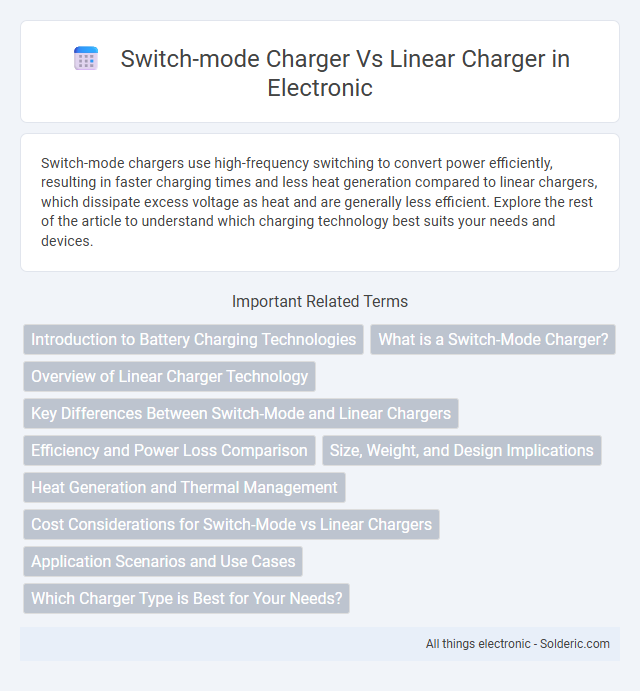Switch-mode chargers use high-frequency switching to convert power efficiently, resulting in faster charging times and less heat generation compared to linear chargers, which dissipate excess voltage as heat and are generally less efficient. Explore the rest of the article to understand which charging technology best suits your needs and devices.
Comparison Table
| Feature | Switch-Mode Charger | Linear Charger |
|---|---|---|
| Efficiency | High (80-95%) | Low to Medium (40-60%) |
| Heat Dissipation | Minimal, cooler operation | High, generates more heat |
| Size and Weight | Compact, lighter due to smaller components | Larger, heavier due to heat sinks |
| Cost | Higher initial cost | Lower cost |
| Complexity | Complex circuit design | Simple design |
| Noise | May produce electromagnetic noise | Silent operation |
| Input Voltage Range | Wide input voltage tolerance | Narrow input voltage range |
| Charging Speed | Faster charging capability | Slower charging speed |
| Applications | Smartphones, laptops, electric vehicles | Low power devices, simple battery charging |
Introduction to Battery Charging Technologies
Switch-mode chargers utilize high-frequency switching regulators to efficiently convert power, minimizing energy loss and heat generation during battery charging. Linear chargers operate by dissipating excess voltage as heat through a variable resistor, resulting in simpler design but lower efficiency and longer charging times. Advances in switch-mode technology have made it the preferred choice for fast, energy-efficient charging in modern electronic devices.
What is a Switch-Mode Charger?
A switch-mode charger is an electronic device that uses high-frequency switching to efficiently convert electrical power and charge batteries with minimal energy loss. It employs components like inductors, capacitors, and transistors to regulate voltage and current, resulting in reduced heat generation and higher efficiency compared to linear chargers. This technology supports faster charging times and is widely used in portable electronics, electric vehicles, and renewable energy systems.
Overview of Linear Charger Technology
Linear charger technology relies on a simple design that regulates voltage by dissipating excess power as heat through a series pass transistor. This method offers low noise and minimal electromagnetic interference, making it ideal for sensitive applications despite its lower efficiency compared to switch-mode chargers. Linear chargers provide precise voltage control and smooth current flow, ensuring safe and stable battery charging, especially for small-scale or low-power devices.
Key Differences Between Switch-Mode and Linear Chargers
Switch-mode chargers convert electrical power using high-frequency switching transistors, resulting in higher efficiency and less heat generation compared to linear chargers, which regulate voltage by dissipating excess power as heat. Linear chargers are simpler, quieter, and produce cleaner output but are less efficient and generate more thermal energy, limiting their use in high-power applications. Switch-mode chargers offer faster charging speeds, lighter weight, and better performance in battery management, making them ideal for modern electronic devices and extended battery life.
Efficiency and Power Loss Comparison
Switch-mode chargers achieve efficiency rates typically between 80% to 95% by rapidly switching components on and off, minimizing power loss as heat. In contrast, linear chargers exhibit efficiencies around 50% to 70% due to continuous operation of pass elements, resulting in significant power dissipation and heat generation. This efficiency disparity makes switch-mode chargers preferable for applications demanding minimal energy waste and thermal management.
Size, Weight, and Design Implications
Switch-mode chargers are significantly smaller and lighter than linear chargers due to their high-frequency operation, which reduces the size of transformers and passive components. The compact design of switch-mode chargers allows for greater flexibility in electronic device integration, making them ideal for portable and space-constrained applications. Linear chargers typically require larger heat sinks and bulkier components, resulting in increased weight and less efficient use of space in device design.
Heat Generation and Thermal Management
Switch-mode chargers produce significantly less heat compared to linear chargers due to their higher efficiency and fast power conversion, which minimizes energy loss as heat. Effective thermal management in switch-mode chargers involves compact heat sinks or active cooling systems, allowing them to remain cool even under heavy loads. Your device benefits from improved reliability and longer lifespan when using a switch-mode charger with superior heat dissipation capabilities.
Cost Considerations for Switch-Mode vs Linear Chargers
Switch-mode chargers are generally more cost-effective in the long run due to higher energy efficiency and reduced heat dissipation, which lowers cooling and component costs. Linear chargers have simpler designs but often incur higher operational expenses because of energy loss and the need for larger heat sinks. When choosing a charger, your budget should factor in both the initial cost and ongoing energy expenses to optimize overall system cost.
Application Scenarios and Use Cases
Switch-mode chargers excel in applications requiring high efficiency and compact size, such as smartphones, laptops, and electric vehicles, where fast charging and minimal heat generation are crucial. Linear chargers suit low-power devices with simpler designs and less sensitivity, including small sensors, wearable devices, and battery trickle charging scenarios. Your choice depends on balancing efficiency, heat management, and design complexity for the specific application environment.
Which Charger Type is Best for Your Needs?
Switch-mode chargers offer higher energy efficiency, faster charging times, and lighter, more compact designs suitable for high-capacity batteries and portable devices. Linear chargers provide simpler design, lower electromagnetic interference, and quieter operation, making them ideal for low-power applications and sensitive electronics. Choosing the best charger depends on your device's power requirements, size constraints, and tolerance for heat and noise.
switch-mode charger vs linear charger Infographic

 solderic.com
solderic.com